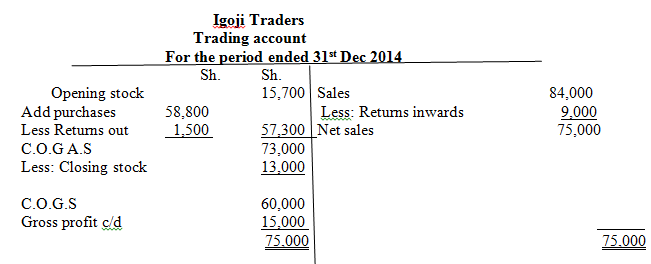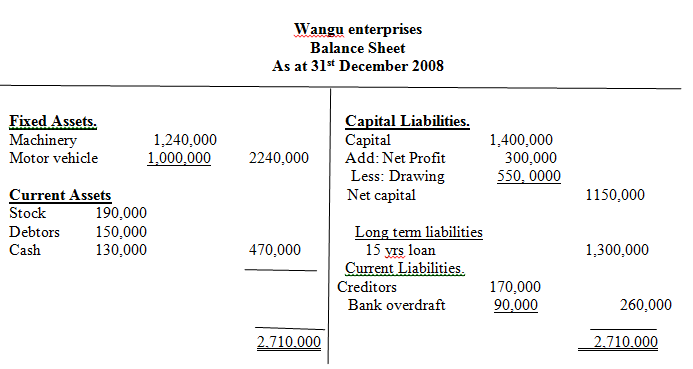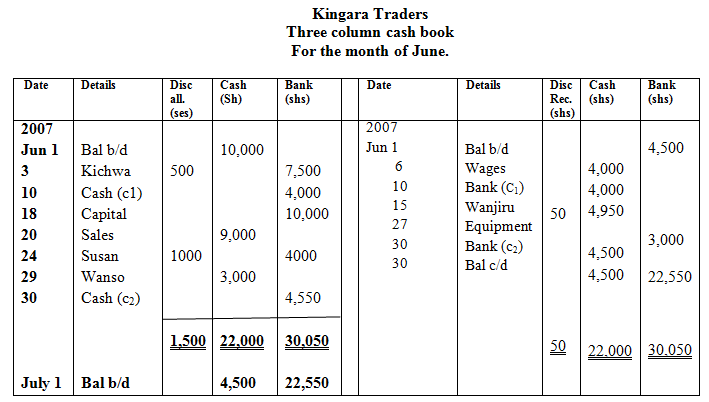INSTRUCTIONS TO CANDIDATES:
- This paper consists of six questions
- Answer any five questions
- All questions carry equal marks
-
- Outline five documents which are required to be filed with the registrar of companies to facilitate the registration of a company. (10mrks)
- Explain five functions of an office. (10mrks)
-
- Muthomi is a trader at Nkubu market who sells carrots, Explain any five factors that could positively affect the quantity of carrot he supplies in the market.(10mrks)
- The following information was extracted from the books of Igoji Traders on 31st December 2014.
Details. Ksh.
Sales 84,000
Purchases 58,800
Opening stock 15,700
Stock on 31/12/2014 13,000
Return out 1,500
Return in 9,000
Required:- Prepare Igoji Traders Trading account for the period ending 31st December 2014. (5mrks)
- Work out IgojiTraders percentage mark up. (2mrks)
- Calculate Igoji traders rate of stock turnover. (3mrks)
-
- Explain five features of an oligopoly. (10mrks)
- Explain five insurance policies that the owner of budget supermarket may find useful for the business. (10mrks)
-
- Outline five differences between department stores and chain stores. (10marks)
- The following balances relate to wangu furniture enterprise as at 31st December 2008.
Machinery. 1,240,000
Stock 190,000
Debtors 150,000
Motor vehicle 1,000,000
Cash 130,000
Drawings 550,000
Creditors 170,000
Bank overdraft 90,000
15 yrs bank loan 1,300,000
Capital 1,400,000
Net profit 300,000
Prepare a balance sheet as at 31st December 2008 showing: (10mrks)- Net capital
- Total current asset.
- Total current liabilities
- Total fixed assets.
-
- Explain Five elements of communication. (10mrks)
- As at 1st June 2007, the cashbook of Kingara traders showed the following balance.
Ksh.
Cash 10,000
Bank 4500(cr)
During the month, the following transactions took place:
June3: Kichwa a debtor settled his account of Ksh. 8000 by cheque of Ksh. 7500.
June 6: Paid wages by cash ksh.4000.
June10: Deposited Ksh.4000 into the business bank account from the cash till.
June15: Settled Wanjirus account of Ksh.5000 and was allowed a discount of 1%.
June20: Cash sales 90000
June24: Susan a debtor settled her account by cheque of Ksh.4000 having been allowed a Discount of 20%.
June 27: Purchased equipment khs.3000 and paid by cheque.
June29: Received Ksh.3000 cash from wariso.
June30: Banked all the available cash except Ksh.4500.
Required: Prepare a three column cash book for the month. (10mrks)
-
- Explain five circumstances that may lead to existence of a business opportunity to be exploited by the entrepreneur. (10mrks)
- Neema roses is a horticultural company producing flowers, explain five factors that may influence the choice of a channel for distributing its flowers. (10mrks)

MARKING SCHEME
-
- Five documents filled to the registrar of companies.
- Memorandum of association – this is a brief statement that specifies the name of the proposed company, amount of capital to be raised the objectives of the company and its proposed headquarters.
- Article of Association – This is a document that contains the set of rules formulated to govern the internal operations of a company.
- A list of directors – This is a document that contains the details of names, addresses, occupation, shares subscribed and statement of agreement by a person to serve as a director.
- Declaration – This is a document that shows whether the registration requirements as laid down by law have been met.
- A statement signed by the directors stating that they have agreed to act as directors.
- Functions of an office.
- Receiving and recording information- information is received in form of telephone calls, tellers reports, bills or invoices. Information is stored in files, computers, registers and micro files for future reference.
- Mailing –the place to prepare and send out letters and parcels.
- Filing – office provide the space for keeping and classifying, records so that they can be referred to easily whenever they are needed.
- Distribution of information – Information is disseminated form external or internal sources.
- Reproduction of document – Documents are reproduced through photocopying, typing, scanning, carbon coping, duplicating and printing.
- Distribution of information – information is disseminated from external or internal sources.
- Safeguarding and controlling organization’s property – Property is protected from theft and damage.
- Five documents filled to the registrar of companies.
-
- Factors that could positively affect Quantity of carrots supplied by Muthomi
- Technology- Modern methods of production will increase the production of carrots.
- Price of carrots – If prices are higher, muthomi will supply more carrots.
- Favourable government policies like subsidies. Will increase the carrots supplied b Muthomi.
- Prices of other related commodities – if the price of related goods decrease, the supply of carrots may increase.
- Climatic factors – favorable climatic conditions will increase the supply of carrots.
- Farmer’s skills – when farmers acquire better skills and training, there will be an increase in carrots produced.
- Cost of production – low cost of production leads to more carrots supplied in the market.
- Availability of inputs – if the inputs of carrots are available, then more carrots will be supplied.
-
-
- Percentage mark up = Gross profit x 100
Cost of sales.
= 15000 x 100
60,000
=25% - Rate of stock Turnover = OS + P-Cs
Average stock
Average stock = 15,700 + 13,000
2
= 14,350
ROST = 15700+58,800-13000
14,350
= 61,500
14,350
= 4.286
-
- Factors that could positively affect Quantity of carrots supplied by Muthomi
-
- Features of oligopoly.
- Firms are independent in decision making/firms observe each other actions/decisions ad hence, acting in a way triggers counter reaction from other firms.
- Firms deal in similar but differentiated products that only differ in aspects such as colour, packaging, branding, pricing etc.
- Firms engage in non-price competition/oligopoly may avoid price wars: hence they only compete through methods like aggressive advertisements and aster sales services.
- Unpredictability/uncertainty of behavior- since firms under an oligopoly keeps reacting to market changes differently depending on the actions taken by other firms within the market firms may be taken by surprise.
- The market is made up of few large firms- firms operating under oligopoly are large firms with a large capital outlay/make extensive use of modern technology/control a substantial market share.
- There is limiting factor to entry- such as large capital investment economies of scale/ collusion/cartels.
- Firms may engage in price wars/price rivalry/cut-throat competition which may lead to survival or collapse of some firms.
- It may lead to price rigidity/kinked demand curve occasioned by fear of other firms reaction/ if a firm tries to sell at a price above the kink, no other firms follows it, but below the kink, all other firms follows it.
- There may be price leadership – where the dominant firm dictate the market price/rule the market.
- Insurance policies useful to budget supermarket owner.
- Loss of profit/consequential loss: this insure against loss caused by temporary closure.
- Fire policy – this aims at compensating the owner for losses arising from fire .
- Theft/Burglary policy- This protects the owner from losses that may occur through theft or burglary.
- Public liability – This assist the owner in paying claims arising from customers who may be insured in the business.
- Fidelity guarantee- To cover losses suffered through workers dishonestly e.g. fraud.
- Workmen’s compensation- this is to assist the workers who may be injured in the cause of duty.
- Motor vehicle- To cover business vehicles in case of accidents.
- Features of oligopoly.
-
- Differences between departmental stores and chain stores.
Chainstores
Departmental stores
i)Have branches/shops in different towns/parts of the country.
ii)Purchases are centralized.
iii)Have standardized prices in all their branches.
iv)Have similar outward appearance in all branches.
v)Slow moving goods can be moved to other branches where demand is high.
vi)A customer can pay for goods in one branch and collect them in another branch.
vii)They sell similar goods/services in all their branches.
viii)Sales are decentralized.
ix)Usually locate in town centres (CBD
i)Have department/shops in the same building under one roof.
ii)Purchases are decentralized
iii)Prices vary in each department according to the goods and services.
iv)Each department is different from the other in terms of outward appearance.
v)Slow moving goods in one department cannot be moved to another department.
vi)Goods paid for in one department can only collected in that department.
viiThey sell different goods/services in each department.
viii)Sales are centralized
ix)Usually located in the outskirts/suburbs/peri –urban aeas.
-
- Differences between departmental stores and chain stores.
-
- Elements of communication.
- Sender – This is the source of information.
- Message- This is the information to be communicated.
- Channel – This is the medium/means to be used when conveying the information.
- Receiver – This is the recipient/party or person to whom the message in meant for.
- Feedback – This is the receivers’ reaction/response to the message.
-
- Elements of communication.
-
- Circumstances that may lead to the existence of a business opportunity to be exploited by the entrepreneur.
- Lack of some products/goods/services- customers may need/require some products/services may not be easily found in their area/market.
- High prices of goods/services/existing market prices may be unnecessarily high hence offering them at a relatively lower prices.
- Excess demand /shortage/inadequate supply of goods and services/ when the quantities of goods available in the market are not sufficient –an opportunity to supply more exist.
- Low/poor quality/substandard products hence creating a room for provision of better/high quality goods/services then this presents an opportunity to offer them.
- Lack/poor/inadequate after sales services an opportunity will exist whole better services are offered after buying/selling of goods/services.
- Unmet social cultural needs/conditions /market niche.
- Innovation/invention/creativity/discovering of new technology/product.
- Need for variety/lack/limited variety.
- Where there is a disasters/catastrophe/occurrence of natural disasters/catastrophe – which creates needs.
- Exploitation of natural resources which stimulates growth of business activities.
- Implementation of development projects which spurs business activities.
- Growth of population which creates demand for goods/services.
- Change in government policy which creates demand for goods/services.
- Factors that may influence the choice of a channel for distributing flowers.
- Nature of the flowers – flowers is perishable and therefore need a short channel in order to be distributed quickly to safeguard them from damage.
- Cost/affordability – The cost of different channels should be considered and the most affordable/cost effective should be used.
- Distance/proximity to the market- if consumers are widespread, long channels may be necessary to reach them.
- Taste/consumer specification-Consumer preferences that might require personal attention of the producer, short/direct channels should be used.
- Where competition is stiff/high – the producers will need to be close to the consumers and hence short channels should be used.
- Volume/Quantity of output – if the quantity of the flower to be sold is large, the more middlemen may be required; where volume is small, a short channel is used
- Availability of intermediaries/agents- if there are no middlemen, shorter channels are used and if available, longer channels are used.
- Government Policy – Where the government policy requires that a certain channel be used, then the firm will have to comply.
- Size of the market – If small/few, a short channel should be used. If many, a longer channel may be used.
- Risks involved – where there is need to spread risks, the firm should used longer channels.
- Circumstances that may lead to the existence of a business opportunity to be exploited by the entrepreneur.
Download BUSINESS STUDIES PAPER 2 - KCSE 2019 STAREHE PRE MOCK EXAMINATION (WITH MARKING SCHEME).
Tap Here to Download for 50/-
Get on WhatsApp for 50/-
Why download?
- ✔ To read offline at any time.
- ✔ To Print at your convenience
- ✔ Share Easily with Friends / Students




